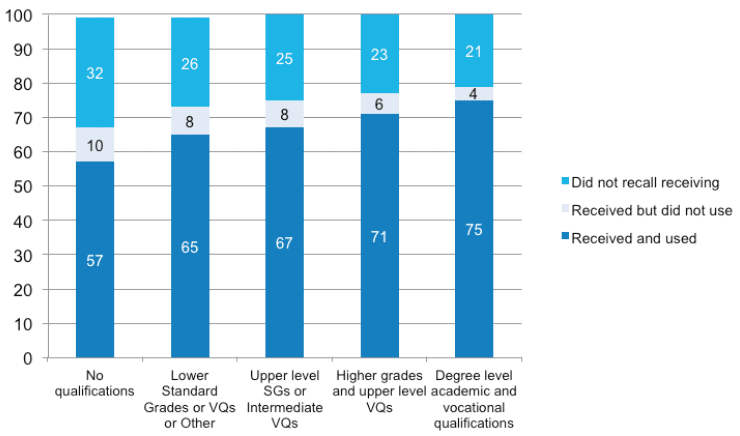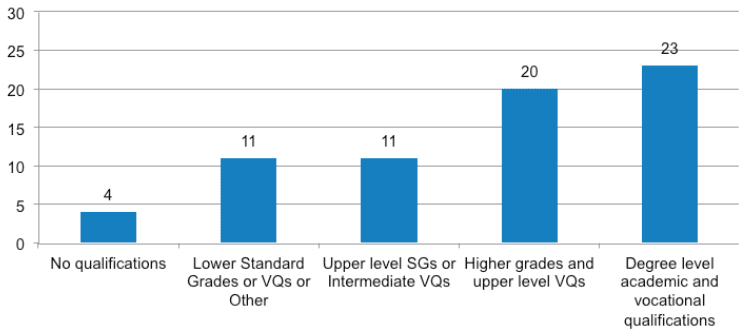Language Development and Enjoyment of Reading: Impacts of Early Parent-Child Activities in Two Growing up in Scotland Cohorts
Language development and enjoyment of reading: impacts of early parent-child activities in two Growing Up in Scotland cohorts.
Chapter 5: Parental Engagement with Bookbug and PlayTalkRead
5.1 Introduction
This chapter specifically considers aspects of two initiatives aimed at encouraging early parent-child activities: the PlayTalkRead campaign which aims to encourage and support parents in engaging actively with their young children, and the Bookbug initiative which seeks to encourage early reading and booksharing through book gifting. As previously noted, GUS children in BC2 were born shortly after each campaign launched, and parents were asked specifically about receipt and use of the initial Bookbug pack and whether they had accessed the PlayTalkRead website. On this basis, GUS BC2 data constitutes an interesting source of information about parents' engagement with these initiatives, although the measures cover only one aspect of each campaign (cf. section 1.2 above)
This chapter outlines receipt and use of the initial Bookbug pack amongst BC2 parents, and the extent to which BC2 parents accessed the PlayTalkRead website. It also describes how engagement with the two initiatives varied by socioeconomic circumstances.
5.2 Key findings
- 77% of parents recalled having received a Bookbug pack by the time their child was aged 10 months. Of those who recalled receiving the Bookbug pack, the vast majority had used at least one of the items enclosed in the pack.
- At the time of the 10 month interview, only 8% of parents had accessed the PlayTalkRead website. At the age 3 interviews this figure had risen to 15%. 82% of parents had not accessed the PlayTalkRead website at either age.
- Those living in more advantaged circumstances (such as in high income households, in the least deprived areas, and with high levels of educational qualifications) were more likely to report having received and used the Bookbug packs and were more likely to have accessed the PlayTalkRead website.
As part of the interview undertaken when their child was 10 months old, parents in BC2 were asked whether they recalled having received a Bookbug pack of books for their child and if so, which items (if any) they had used. [26]
The majority (77%) of BC2 parents recalled having received a Bookbug pack by the time their child was 10 months old (Table 5.1). Of those who recalled receiving the Bookbug pack, the vast majority used one or more of the items enclosed in the pack. Amongst those who used the Bookbug resource, the most popular items in the pack were the books: 73% of parents who recalled having received the Bookbug pack regularly read the books to their child, while 20% had read the Bookbug books to their child once. In addition to this, 26% of parents had read the enclosed magazine, 22% regularly listened to the CD, and 22% had listened to the CD once.
Table 5.1 Receipt and use of Bookbug
| Whether recalled receiving and using Bookbug | ||||
|---|---|---|---|---|
| Received and used | Received but did not use | Did not recall receiving | ||
| BC2 | % | 71 | 6 | 23 |
| Unweighted bases | 4389 | 349 | 1365 | |
Receipt and use of Bookbug resources varied by socio-economic measures of disadvantage, with parents living in the most advantaged circumstances more likely to have received and used the Bookbug resources. Figure 5‑A below illustrates these differences by showing receipt and use of the Bookbug resources by parental level of education. Similar patterns were identified for household level of income and for area deprivation. For example, 76% of BC2 parents in the highest income quintile had received and used Bookbug, compared with 64% of parents in the lowest income quintile. 75% of parents living in the least deprived areas had received and used Bookbug compared with 62% of those in the most deprived areas. [27]
Figure 5‑A Receipt and use of Bookbug pack, by parental level of education (%)

Unweighted base: BC2: n=6103.
5.4 PlayTalkRead website
At both the age 10 month and age 3 interviews, GUS respondents were asked whether they had accessed a number of government services and schemes aimed at helping parents and families. Amongst these was the PlayTalkRead website. As such, GUS data includes a useful measure of whether parents had used the PlayTalkRead website when their child was 10 months and 3 years old, respectively. Again, note that this is not a measure of parents' awareness of or engagement with the PlayTalkRead campaign as a whole (cf. section 1.2).
At the time of the 10 month interview, only 8% of parents had accessed the website. At the age 3 interviews this figure had risen to 15%. Overall, 4% of BC2 parents reported that they had accessed the PlayTalkRead website at both the 10 month and the age 3 interviews, while 14% had accessed the website either by the 10 month interview or the age 3 interview. The vast majority (82%) had not accessed the PlayTalkRead website at all.
Table 5.2 Whether accessed PlayTalkRead website
| Whether accessed PlayTalkRead website | ||||
|---|---|---|---|---|
| Accessed at both ages | Accessed at one age only | Did not access | ||
| BC2 | % | 4 | 14 | 82 |
| Unweighted bases | 234 | 728 | 4051 | |
Similar to receipt and use of the Bookbug resources, accessing the PlayTalkRead website varied by socio-economic circumstances, with those living in more advantaged circumstances (such as in high income households, in the least deprived areas, and with high levels of educational qualifications) more likely to have accessed the website. For example, 24% of parents in the highest income quintile had accessed the PlayTalkRead website, while only 13% of those in the lowest income quintile had done so. 21% of parents living in the least deprived areas had accessed the PlayTalkRead website, compared with 15% of parents living in the most deprived areas. Figure 5‑B below shows that amongst families where at least one adult in the household was educated to degree level, 23% had accessed the PlayTalkRead website compared with only 4% amongst those who had no formal qualifications. [28]
Figure 5‑B % of parents who accessed the PlayTalkRead website

Unweighted base: BC2: n=5018.
Contact
There is a problem
Thanks for your feedback